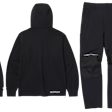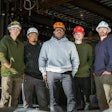
Jobsite safety is paramount as construction workers navigate heavy machinery, vehicular traffic and ever-changing environmental conditions. Struck-by incidents result in injuries, deaths, lost work and workers’ compensation costs.
Personal Protective Equipment (PPE) such as high-visibility vests help construction workers stand out through high-visibility colors, reflective stripes, material and design. Other factors include the class of safety vest and whether it meets regulatory standards.
As this IRONPROS story notes, hi-visibility or reflective vests are designed to offer protection through the greatest visibility from the furthest distance compared to normal dyed clothes.
Safety Standards and Types
The Occupational Safety and Health Administration (OSHA) requires employers to assess workplace hazards to determine if high-visibility safety vests are needed and if so to provide the appropriate vest for the job at no cost to the employee, along with training on proper use, care and maintenance.
The ANSI/ISEA 107-2020 standard classifies high-visibility vests on different standards and ratings.
- Type R, used in roadway work, provides daytime and nighttime visual enhancements and encompasses Class 2 and Class 3.
- Type 0 is used for off-road use in low-risk situations or where traffic is under 25 mph and encompasses only Class 1 safety vests, providing moderate visibility.
- Type P safety vests encompass Class 2 and Class 3 and are used by first responders.
Safety Vest Classifications
Class 1 safety vests are used for work in the lowest risk areas, such as away from an active roadway and where the background is not complex. They are worn on worksites where traffic is travelling no more than 25 mph. They can be safety yellow or safety orange and utilize at least 155 square inches of reflective stripes.
Class 2 stands out against a background of many colors and depth, provides additional high visibility materials and enables worker detection and identification from longer distances. The vests also are worn for work in inclement weather. Class 2 safety vests are worn day or night on worksites where traffic flows from 25 to 50 mph.
A Type R Class 3 vest is used when jobs necessitate high visibility, mobility and flexibility, such as working in traffic with speeds exceeding more than 50 mph. They feature the most background material and reflective striping.
Designs and Colors
All ANSI classes of safety vests must have background and retroreflective/combined performance material. Approved colors are yellow-green, orange-red and red (for first responders).
The best color choice that achieves the highest degree of worker contrast to the environment is addressed in this IRONPROS article.
Green high-visibility vests are designed to provide excellent visibility in daylight, low-light, minimal artificial lighting, or at dawn or dusk. High-visibility green worn on road projects helps the worker stand out from among orange cones, barriers and machinery. Green may help workers stand out in an urban environment against a black or gray roadway.
Safety green – with a 70 percent luminance factor – is more visible than orange and is considered suitable for construction sites with multifaceted backgrounds that may include heavy machinery and high-rising structures. With its 40 percent luminance factor, orange is highly visible in daylight environments where there is a mix of workers, vehicles and equipment. It stands out in most backgrounds and can be suitable for rural and urban areas.
Safety vest striping is made of retroreflective material, offering high visibility at night. Typically silver, white, or gray striping is placed on the vest in an ‘H’ in the front and ‘X’ pattern on the back. Contrasting tape includes high-visibility striping below the reflective layer. Some vests may have combined-performance striping matching the background material for optimal daytime and nighttime visibility.
An ANSI-rated high-visibility vest label notes its type, class, fire-resistant rating, applicable ARC rating and size and the ANSI standards it meets.
The fit of a safety vest – including for women construction workers – is key as to not present any safety hazards such as getting caught on jobsite materials. This story notes concerns about the sizing of safety vests to accommodate the changing gender demographics on the jobsite.
The study also highlights concerns over a lack of maternity safety vests, which should provide adjustment options such as waist cinching for their current vests.
Workers should always consult a company’s safety manager for help choosing the correct PPE, including safety vests.















